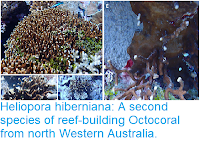The Great Barrier Reef on Australia’s east coast is the world’s largest marine protected area, a World Heritage Site and a biodiversity hotspot of global importance. Despite this, the reef is estimated to have lost more than 50% of its Corals during the past three decades. Much of this is due to global warming, and the accompanying acidification of the seawater, but other factors are important. One of these has been repeated outbreaks of the Crown-of-Thorns Starfish, Acanthaster solaris, a Coral-consuming Echinoderm credited with having caused 42% of Coral loss on the Great Barrier Reef prior to the bleaching events of 2016-17. The Crown-of-Thorns Starfish has entered a boom-and-bust population cycle since the 1960s, with outbreaks producing huge numbers of Starfish that consume all the available food (i.e. Coral) then die out due to starvation. The precise cause of these booms is unclear, but probably linked to the life-cycle of the Starfish, which produce planktonic larvae, with the most likely explanation being greater numbers of larvae surviving because of increased food availability due to nutrients from agricultural runoff, or increased larval survival due to a reduced number of predators caused by overfishing. This makes Starfish booms of great interest to conservationists trying to protect the Great Barrier Reef, who need to detect new outbreaks as quickly as possible in order to take remedial action.
An adult Crown-of-Thorns Starfish predating Coral. Hall et al. (2017).
In a paper published in the journal Coral Reefs on 12 September 2018, Sven Uthicke of the Australian Institute of Marine Science, Miles Lamare of the Department of Marine Science at the University of Otago, and Jason Doyle, also of the Australian Institute of Marine Science, describe the results of a trial of a method which used environmental DNA to track populations of the Crown-of-Thorns Starfish.
Environmental DNA (or eDNA) is DNA shed into the environment by an organism via shed skin cells, and excretion of mucus, urine or faeces. The detection of eDNA has become a standard methodology for detecting invasive of endangered species in freshwater environments, but the much larger volume of the oceans, which means that the eDNA will be significantly more diluted by the water, makes detecting eDNA in marine environments considerably harder, and the technique has yet to be successfully applied in this setting.
In order to establish the amount of eDNA produced by Crown-of-Thorns Starfish a single individual was placed in a 10 000 litre seawater tank at the Australian Institute of Marine Science’s National Sea Simulator. This tank had continuous through-flow of water at a rate that would replace all the water twice a day, and the Starfish was kept in it and monitored for one week. This was then repeated with two Starfish, then three, up to a maximum of sixteen, in order to calibrate the methods used for eDNA detection.
Seawater was then collected on four field trips between June 2016 and August 2017, covering reefs in the Cooktown, Innisfail and Ingham to Townsville regions, and tested for levels of Crown-of-Thorns Starfish eDNA. The areas covered included two reefs where there had previously been Starfish outbreaks, two where the Starfish had never been observed, five reefs with active outbreaks, and two reefs without outbreaks, but which were 50-65 km from a reef where and outbreak was ongoing.
No Crown-of-Thorns Starfish eDNA was detected at any site where the Starfish were not present, but it was found in the samples from all the reefs where the Starfish were observed. Furthermore, the levels of eDNA found in the samples closely reflected the known densities of Starfish on these reefs, indicating that the test is both a viable method for detecting the Starfish and a reliable way to estimate their population density.
Environmental DNA (or eDNA) is DNA shed into the environment by an organism via shed skin cells, and excretion of mucus, urine or faeces. The detection of eDNA has become a standard methodology for detecting invasive of endangered species in freshwater environments, but the much larger volume of the oceans, which means that the eDNA will be significantly more diluted by the water, makes detecting eDNA in marine environments considerably harder, and the technique has yet to be successfully applied in this setting.
In order to establish the amount of eDNA produced by Crown-of-Thorns Starfish a single individual was placed in a 10 000 litre seawater tank at the Australian Institute of Marine Science’s National Sea Simulator. This tank had continuous through-flow of water at a rate that would replace all the water twice a day, and the Starfish was kept in it and monitored for one week. This was then repeated with two Starfish, then three, up to a maximum of sixteen, in order to calibrate the methods used for eDNA detection.
Seawater was then collected on four field trips between June 2016 and August 2017, covering reefs in the Cooktown, Innisfail and Ingham to Townsville regions, and tested for levels of Crown-of-Thorns Starfish eDNA. The areas covered included two reefs where there had previously been Starfish outbreaks, two where the Starfish had never been observed, five reefs with active outbreaks, and two reefs without outbreaks, but which were 50-65 km from a reef where and outbreak was ongoing.
No Crown-of-Thorns Starfish eDNA was detected at any site where the Starfish were not present, but it was found in the samples from all the reefs where the Starfish were observed. Furthermore, the levels of eDNA found in the samples closely reflected the known densities of Starfish on these reefs, indicating that the test is both a viable method for detecting the Starfish and a reliable way to estimate their population density.
Density estimates of Acanthaster solaris (left) and eDNA concentration on 11 reefs of the Great Barrier Reef, Australia. Uthicke et al. (2018).
See also...
Follow Sciency Thoughts on Facebook.








